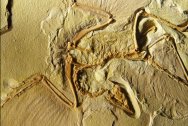Newly-Announced
Archaeopteryx Specimen Shows Closer Affinity With Dinosaurs
The December 2, 2005 issue of Science contains a paper by Mayr
et al that outlines the features of the tenth skeletal example
of the urvogel Archaeopteryx. Like all previous examples, this
one was originally privately held, in this case since the 1970s
by a former employee of one of the Solnhofen quarries. Upon his
death, his widow approached the Senckenberg Museum, Frankfurt,
Germany, about a possible sale. Ultimately, an anonymous individual
acquired the specimen which will be curated by the Wyoming Dinosaur
Center, Thermopolis, Wyoming on long-term loan some time in 2006-2007,
with a cast to be retained by the Senckenberg.
 The
Termopolis specimen is only slightly dissociated and very complete
on a single limestone slab. In addition to exquisitely-preserved
bones, the impressions of both wing and tail feathers are present.
Several features point out the close association of Archaeopteryx
with the theropod dinosaurs. The skull is the best-preserved of
all the specimens to date, and the only one preserved in dorsal
view, allowing for the study of previously poorly-known features.
The palatine bone is four-pronged as in theropods, as opposed
to three-pronged as in more modern birds. Further evidence of
the theropod nature of Archaeopteryx can be found in the foot.
The anklebones are preserved in frontal view, clearly showing
that it had the same kind of ankle as the theropod dinosaurs.
Additionally, preservation of the foot shows characteristics like
the “raptors”, in that it possessed a hyperextendible
second toe, a feature previously evident in birds only in the
“flying raptor” Rahonavis from the Cretaceous of Madagascar.
Another feature evident in the foot of the new specimen is that
the first toe is NOT reversed as in perching birds, therefore
indicating that Archaeopteryx was not fully-arboreal (perhaps
lending additional credence to the “ground up” theory
of bird origins – though not mentioned in the paper). The
features present in this specimen will provide much fuel in the
debate upon both the origins of flight in birds and the relationship
of Archaeopteryx to both theropod dinosaurs and more advanced
birds for years to come.
The
Termopolis specimen is only slightly dissociated and very complete
on a single limestone slab. In addition to exquisitely-preserved
bones, the impressions of both wing and tail feathers are present.
Several features point out the close association of Archaeopteryx
with the theropod dinosaurs. The skull is the best-preserved of
all the specimens to date, and the only one preserved in dorsal
view, allowing for the study of previously poorly-known features.
The palatine bone is four-pronged as in theropods, as opposed
to three-pronged as in more modern birds. Further evidence of
the theropod nature of Archaeopteryx can be found in the foot.
The anklebones are preserved in frontal view, clearly showing
that it had the same kind of ankle as the theropod dinosaurs.
Additionally, preservation of the foot shows characteristics like
the “raptors”, in that it possessed a hyperextendible
second toe, a feature previously evident in birds only in the
“flying raptor” Rahonavis from the Cretaceous of Madagascar.
Another feature evident in the foot of the new specimen is that
the first toe is NOT reversed as in perching birds, therefore
indicating that Archaeopteryx was not fully-arboreal (perhaps
lending additional credence to the “ground up” theory
of bird origins – though not mentioned in the paper). The
features present in this specimen will provide much fuel in the
debate upon both the origins of flight in birds and the relationship
of Archaeopteryx to both theropod dinosaurs and more advanced
birds for years to come.
Mayr,
G, Pohl, B & Peters, DS. A Well-Preserved Archaeopteryx Specimen
with Therapod Features. Science, 310, 1483 - 1486, (2005).